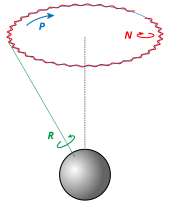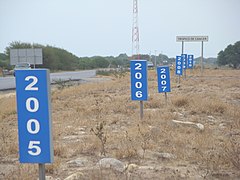Nutation

Nutation (from Latin nūtātiō, "nodding, swaying") is a rocking, swaying, or nodding motion in the axis of rotation of a largely axially symmetric object, such as a gyroscope, planet, or bullet in flight, or as an intended behaviour of a mechanism. In an appropriate reference frame it can be defined as a change in the second Euler angle. If it is not caused by forces external to the body, it is called free nutation or Euler nutation.[1] A pure nutation is a movement of a rotational axis such that the first Euler angle is constant.[citation needed] In spacecraft dynamics, precession (a change in the first Euler angle) is sometimes referred to as nutation.[2]
Rigid body
If a top is set at a tilt on a horizontal surface and spun rapidly, its rotational axis starts precessing about the vertical. After a short interval, the top settles into a motion in which each point on its rotation axis follows a circular path. The vertical force of gravity produces a horizontal torque τ about the point of contact with the surface; the top rotates in the direction of this torque with an angular velocity Ω such that at any moment
where L is the instantaneous angular momentum of the top.[3]
Initially, however, there is no precession, and the top falls straight downward. This gives rise to an imbalance in torques that starts the precession. In falling, the top overshoots the level at which it would precess steadily and then oscillates about this level. This oscillation is called nutation. If the motion is damped, the oscillations will die down until the motion is a steady precession.[3][4]
The physics of nutation in tops and gyroscopes can be explored using the model of a heavy symmetrical top with its tip fixed. Initially, the effect of friction is ignored. The motion of the top can be described by three Euler angles: the tilt angle θ between the symmetry axis of the top and the vertical; the azimuth φ of the top about the vertical; and the rotation angle ψ of the top about its own axis. Thus, precession is the change in φ and nutation is the change in θ.[5]
If the top has mass M and its center of mass is at a distance l from the pivot point, its gravitational potential relative to the plane of the support is
In a coordinate system where the z axis is the axis of symmetry, the top has angular velocities ω1, ω2, ω3 and moments of inertia I1, I2, I3 about the x, y, and z axes. The kinetic energy is
In terms of the Euler angles, this is
If the Euler–Lagrange equations are solved for this system, it is found that the motion depends on two constants a and b (each related to a constant of motion). The rate of precession is related to the tilt by
The tilt is determined by a differential equation for u = cos(θ) of the form
where f is a cubic polynomial that depends on parameters a and b as well as constants that are related to the energy and the gravitational torque. The roots of f are cosines of the angles at which the rate of change of θ is zero. One of these is not related to a physical angle; the other two determine the upper and lower bounds on the tilt angle, between which the gyroscope oscillates.[6]
Astronomy
The nutation of a planet happens because of gravitational attraction of other bodies that cause the precession of the equinoxes to vary over time so that the speed of precession is not constant. The nutation of the axis of the Earth was discovered in 1728 by the English astronomer James Bradley.
Earth

Nutation makes a small change to the angle at which the Earth tilts with respect to the Sun, changing the location of the major circles of latitude that are defined by the Earth's tilt (the tropical circles and the polar circles).
In the case of the Earth, the principal sources of tidal force are the Sun and Moon, which continuously change location relative to each other and thus cause nutation in Earth's axis. The largest component of Earth's nutation has a period of 18.6 years, the same as that of the precession of the Moon's orbital nodes.[1] However, there are other significant periodic terms that must be accounted for depending upon the desired accuracy of the result. A mathematical description (set of equations) that represents nutation is called a "theory of nutation". In the theory, parameters are adjusted in a more or less ad hoc method to obtain the best fit to data. Simple rigid body dynamics do not give the best theory; one has to account for deformations of the Earth, including mantle inelasticity and changes in the core–mantle boundary.[7]
The principal term of nutation is due to the regression of the Moon's nodal line and has the same period of 6798 days (18.61 years). It reaches plus or minus 17″ in longitude and 9.2″ in obliquity.[8] All other terms are much smaller; the next-largest, with a period of 183 days (0.5 year), has amplitudes 1.3″ and 0.6″ respectively. The periods of all terms larger than 0.0001″ (about as accurately as one[who?] can measure) lie between 5.5 and 6798 days; for some reason (as with ocean tidal periods) they seem to avoid the range from 34.8 to 91 days, so it is customary to split the nutation into long-period and short-period terms. The long-period terms are calculated and mentioned in the almanacs, while the additional correction due to the short-period terms is usually taken from a table.
In popular culture
In the 1961 movie The Day the Earth Caught Fire, the near-simultaneous detonation of two super-hydrogen bombs near the poles causes a change in the Earth's nutation, as well as an 11 degree shift in the axis of rotation and a change in the Earth's orbit around the Sun.
See also
References
- ^ a b Lowrie, William (2007). Fundamentals of geophysics (2nd ed.). Cambridge [u.a.]: Cambridge Univ. Press. pp. 58–59. ISBN 9780521675963.
- ^ Kasdin, N. Jeremy; Paley, Derek A. (2010). Engineering dynamics : a comprehensive introduction. Princeton, N.J.: Princeton University Press. pp. 526–527. ISBN 9780691135373.
- ^ a b Feynman, Leighton & Sands 2011, pp. 20–7[, clarification needed],
- ^ Goldstein 1980, p. 220
- ^ Goldstein 1980, p. 217
- ^ Goldstein 1980, pp. 213–217
- ^ "Resolution 83 on non-rigid Earth nutation theory". International Earth Rotation and Reference Systems Service. Federal Agency for Cartography and Geodesy. 2 April 2009. Retrieved 6 August 2012.
- ^ "Basics of Space Flight, Chapter 2". Jet Propulsion Laboratory. Jet Propulsion Laboratory/NASA. 2013-10-29. Retrieved 2015-03-26.
Further reading
- Feynman, Richard P.; Leighton, Robert B.; Sands, Matthew (2011). The Feynman lectures on physics (New millennium ed.). New York: BasicBooks. ISBN 978-0465024933.
{{cite book}}: Invalid|ref=harv(help) - Goldstein, Herbert (1980). Classical mechanics (2d ed.). Reading, Mass.: Addison-Wesley Pub. Co. ISBN 0201029189.
{{cite book}}: Invalid|ref=harv(help) - Lambeck, Kurt (2005). The earth's variable rotation : geophysical causes and consequences (Digitally printed 1st pbk. ed.). Cambridge: Cambridge University Press. ISBN 9780521673303.
- Munk, Walter H.; MacDonald, Gordon J.F. (1975). The rotation of the earth : a geophysical discussion. Reprint. with corr. Cambridge, Eng.: Cambridge University Press. ISBN 9780521207782.






